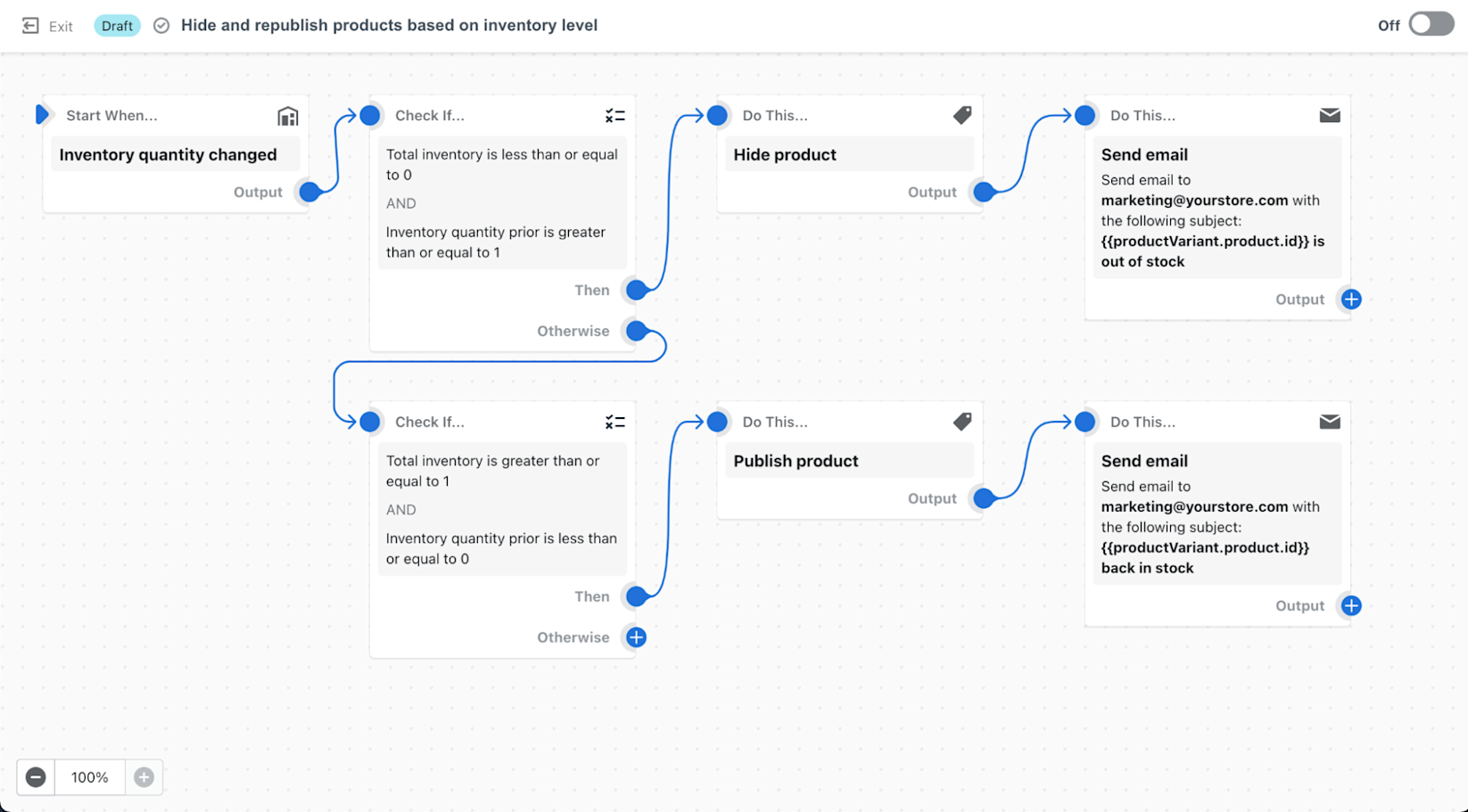This is a special contribution from David Moellenkamp, Director of Product at Shopify Plus.
Every retailer executes hundreds if not thousands of small tasks that take between two and five minutes every day. Individually, they never appear to be a significant time-waster. But together, they devour productivity and stunt growth. Research recommends that rather thanfocusing on incremental change, focus on improvements that can fundamentally change how your organization operates.
Ecommerce automationis about giving your people and yourself the most important thing you can: time. More than that, it unleashes your teams to invest in high value work in our current climate: retraining staff on new fulfillment processes, crisis communications, working out new deals with suppliers, dealing with HR challenges, experimentation, sales and marketing, and product iteration.
Thousands of online retailers have put ecommerce automation to work with Shopify Plus. Even more impressive are the hard numbers behind those businesses: 1.1 billion workflows—decisions offloaded—each one eliminating a process that used to be manually operated. In total, that’s 9.2 million hours in time saved (or more than 1000 years).
In this post, we uncover how ecommerce automation can save you time to streamline costs and focus your attention on what matters.
- What is ecommerce automation?
- Examples of ecommerce automations
- How can you automate your ecommerce operation?
- Whose time are you saving with ecommerce automation?
What is ecommerce automation?
Ecommerce automation is software built to convert tasks, processes, or campaigns within your business to automations that intelligently execute exactly when needed. It’s how businesses can do more with what they have.
The problem is simple: as a business scales, the demands, complexity, and repetition add up. Systems that used to work become increasingly inefficient and break down. In response, companies turn to time-consuming workarounds—time that could be spent on what’s important is sacrificed for time spent on what’s urgent, even when that’s just pushing buttons.
Or companies turn to new hires. Unfortunately, people don’t scale. But that doesn’t undercut the value of people—if anything, it reinforces it. People, especially their time and energy, are your most powerful resource.
Examples of ecommerce automations
Ecommerce automations can take a host of different forms like tagging customers for segmentation and marketing, standardizing visual merchandising, streamlining tracking and reporting, and halting high-risk orders. With each workflow, the goal is the same: to simplify tasks.
Below are some examples of reduced manual tasks:
- Fulfillment:When an item is ready to be in store, trigger an email or SMS or Facebook message to the customer
- Inventory levels:Unpublish out-of-stock products and send a Slack message or email to your marketing team so they can pause advertising
Good Americanused Flow to automatically tag products so they display as OUT OF STOCK on its site when they were sold out, or to display as LOW STOCK when its quantities dipped below a certain threshold.
“It’s an extra incentive or nudge to buy when customers see we’re running low on a product,” Mehmet Dokumcu, Good American’s executive vice president of digital and commerce, says. “If we’re out of stock, it also gives shoppers an opportunity to sign up to be notified when the product is back in stock, which results in future sales we otherwise might miss.”
- Best sellers:Re-add out-of-stock products to the online store when they’re back in stock
- Customer loyalty:Automatically tag high-value customers for segmentation and notify customer service to send a personalized thank you message, or apply discounts or specialized shipping rules to customers with email addresses or tags like “Loyalty Member”
- High-risk orders:Instantly flag and notify internal security teams of high-risk orders, like if a bot quickly buys out all of your stock
- Manage donations:Keep track of dollars donated via Slack and a spreadsheet
- Order tagging:Tag restricted shipping zones and hold payment from customers trying to ship to those locations. Alert staff to offer customers store credit to spend on their next purchase or a refund
- Customer preferences:Show and hide payment options relative to customer criteria like order history, location, and device
- Channel preferences:Identify, tag, and segment customers who buy from specific sales channels, such as Amazon, Facebook, Pinterest, and more
- Scheduled sales:Price changes and promotions for predetermined time periods
- Discounts:Adjust prices at checkout based on product combinations, quantity, or customer location
- Scheduled product releases:Preload new products and publish them to your store, social media, apps, and sales channels simultaneously. Rollout and rollback entire theme changes for seasonal promotions or product drops
Home goods retailerScandiscreated seven active workflows across three different Shopify storefronts, including one to track commissions from their in-store associates at 32 brick-and-mortar locations.
It’s also created Flows to:
- Automate employee discounts
- Manage their inventory and reordering processes
- Optimize their refund reports saving them hundreds of hours every year
- Unpublish and publish products due to availability, warehouse movements, and returns
The possibilities are endless.
Read more:Ecommerce Automation Software: 10 Shopify Flow Workflow Templates
How can you automate your ecommerce operation?
Creating your own in-house systems or engineering your own connections between your platform and tools requires a lot of work. Shopify Flow is an out-of-the-box solution you can use to create automated workflows across your online store and apps.

Start automating in seconds with easy-to-use templates. Shopify Flow follows a trigger, condition, and action logic created through an easy-to-use visual builder. Workflows can be built and deployed in minutes, or you can use pre-madeworkflow templates, both without ever writing a single line of code.

Shopify Flow can also be combined with many other tools, shown below:
自动化工具,与Shopify集成流
Apps that connect with Shopify Flow to increase sales
Apps that connect with Shopify Flow to improve the customer experience
Whose time are you saving with ecommerce automation?
电子商务在采用自动化的效果最好terconnected roles and departments within an organization. Just remember, this is far from a comprehensive picture. The following examples represent a small sample of the automations you can create with Flow.
Operations managers
Ecommerce operations can use automation for a host of inventory, shipping, and product-related workflows. To standardize visual merchandising and make discoverability easy, products can be automatically tagged and added to collections based on their title, SKU, or type.
When stock gets low, Flow can send you alerts or be used to email a supplier to reorder. In a similar vein, out-of-stock or discontinued items can automatically be taken down and then republished once the inventory arrives.
Customer service
Flow lets you tag customers based on conditions like order value, and acquisition channel. Beyond simply creating segments for marketing and retention, customer service can be instantly notified over Slack or email to reach out with a personalized thank you message or loyalty program invitation.
Likewise, when an item is returned, customer service can be prompted to follow up on whatever communication channel the customer last used—email, social, Messenger, or phone.
Fraud prevention
To safeguard order fulfillment, Flow can be used to augment Shopify Plus’existing risk analysis. Already, when high-risk orders are identified—through an IP address check, address verification system (AVS), or Shopify’s own database—they’re automatically halted or flagged for review.
In addition, ecommerce automation can then be configured to notify your own security or fraud-prevention specialists for hands-on review, potentially saving you thousands of dollars in chargebacks and lost revenue.
Marketing and advertising
When new products are added to a storefront, marketing departments can be notified, forwarded product details, and prompted to start advertising. Marketing teams can also be notified when inventory is running low on specific products to pause promotion and optimize ad spend.
Scheduling sale changes in advance allow marketing teams to better plan promotions, and reduce errors and downtime for the rest of the team. Best of all, customers may be tagged at checkout based on a host of criteria for personalized marketing.
Design
For retailers who specialize in customized products, order specifications can be sent directly to the design team’s workflow, eliminating the need for designers to run reports or perform unnecessary administrative work.
Designers themselves can use Flow to leverage a host of marketing tactics—“back-in-stock” banners, overlays, and action-oriented visual cues like “buy now—limited quantity remaining\"—all of which are published and unpublished automatically based on tags referenced by the theme.
Web development
Next to operations managers and security, developers may actually stand to gain the most from automation.
Theme changes, merchandising opportunities, email captures when an item goes out of stock, free-gifts on selected purchases, and displaying the best payment or shipping options can all be customized through ecommerce automation. Once created, these rules remove the need to code and recode repetitive updates that bog down dev’s resources and time.
Save time with Shopify Flow
Want to start streamlining costs and getting value for your platform investment? Shopify Flow can help you do more with what you have.
Ecommerce Automation FAQ
Why do you use ecommerce automation?
Ecommerce automation can help businesses streamline and automate their online sales and marketing processes. By automating processes such as customer service, order tracking, payment processing, inventory management, and marketing campaigns, businesses can save time and money while increasing customer satisfaction. Automation can also help improve customer loyalty, reduce customer churn and help businesses gain better insights into their customers and their preferences, resulting in more effective marketing and sales strategies. Shopify Flow, for example, allows you to turn manual tasks into automated workflows. With Launchpad, you can automate flash sales, product drops, and marketing campaigns.
Does ECOM automation work?
Yes, ECOM automation can work. Automation is a powerful tool for streamlining repetitive tasks and improving efficiency, and it can be used to improve the efficiency of ECOM operations. Automation can help reduce the time and cost associated with manual tasks, improve accuracy, and create a more efficient workflow.
What is the impact of automation in ecommerce?
自动化电子商务有广泛的影响s, both positive and negative. On the positive side, automation can help reduce costs, improve efficiency, and provide customers with a better shopping experience. Automation can help streamline operations, reducing the need for manual labor, and improve accuracy. Automation can also help ecommerce businesses increase customer satisfaction by providing faster response times and better customer service. On the other hand, automation can lead to job losses, as humans are replaced by automated systems. Automation can also lead to decreased customer engagement, as customers may feel less connected to the company or brand.
What are ecommerce automations on Shopify?
Ecommerce automations on Shopify are automated processes that are designed to help merchants save time, increase efficiency, and improve customer service. Examples of ecommerce automations on Shopify include: automated emails, abandoned cart recovery, order notifications, and customer segmentation. With Shopify Flow, merchants can put repetitive, labor-intensive tasks on autopilot, without needing to touch a single line of code. Additionally, Shopify offers a range of third-party apps that facilitate more advanced automations for merchants, including marketing automation, inventory tracking, and shipping automations.
Read More
- Consumer Psychology: Sell to the Person Behind the Persona
- How I Raised $1.1 Million Without a Network or Experience
- The Dirty Little Secret Traditional Enterprise Software Companies Don't Want You Knowing
- Stop Trying to Increase Your Conversion Rates
- Back-to-School Ecommerce: Infographic & Lessons from $58.1B in Online Sales
- Ecommerce Customer Service: Holiday Insights Direct from 10 Industry Leaders
- Artificial Intelligence: Armageddon or Nirvana? Experts Predict What Happens Next






